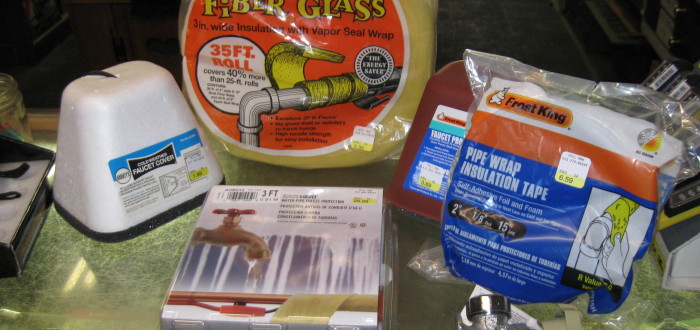I was just outside and it is a balmy (for an Ohio January) 40 degrees, not too bad. But when I got up this morning it was only 5 degrees, that’s pipe freezing weather. One thing we haven’t talked about are tricks to prevent you pipes from freezing during bitter Winter weather. Last Winter, with our repeated polar vortex weather we had a couple of problems with frozen pipes, both at home and here at the store. One of the problems with predicting when you might have frozen pipe trouble is that all houses and buildings are different. Depending on when and how well they were built, the temperature that can cause a frozen pipe can vary quite a bit. Technically it only has to be below 32 degrees for water to start to freeze, but most water pipes are either buried or protected in a heated building to some extent.
The first item that you have to consider is your water supply. If you live in town and have city water, most customers are supplied by a buried water feed off the main under the street. These are usually deep enough that they are safe from becoming frozen. At home we have a well, and it is the older kind with a well house. The well itself won’t freeze, but the pipe has frozen where it comes out of the well before it enters the buried run to the house. I have to keep a heat source out in the well house. I use a floodlight to provide heat, it works pretty well, I just have to make sure that it doesn’t burn out during a cold snap. Newer wells are usually buried out in the yard and are pretty freeze resistant.
Another type of freeze protection is to use heat tape. This plugs in and is run along the pipe to keep it warm. It also must have pipe insulation over it to provide the best protection. Insulation by itself helps some, but if it gets too cold, or if the water doesn’t run often, the pipe can get cold enough that it can freeze. Running the water by the way, is a good way to keep it from freezing. Leaving a couple faucets running just a trickle will keep the water moving and prevent cold spots that will freeze. We usually let the kitchen faucet run just a little when it gets below 10 degrees. Sure it wastes a little water, but believe me, it is nothing compared to the flood you will get from a burst pipe.
Outdoor faucets are the most notorious for freezing. They stick out into the cold wind, and are often piped through a crawl space that is not well heated. Many people shut off their outside sillcocks for the Winter if they don’t need them. Others, especially if they have animals to water have to keep their outside water functional all Winter. The way to do this is to use a hydrant. A hydrant (like a fire hydrant) is a special valve designed so that the actual valve is located in an area that does not freeze, either below ground, or inside the wall. The hydrant is also designed so that any water remaining in the valve drains out so that it does not freeze. Just remember that you have to disconnect any hose that you might have attached to the hydrant so that it can drain and do its job. Hydrants are made for both wall and yard mounting and while they are more expensive than a regular valve they are the way to go if you need a reliable supply of water all Winter.
Well, that’s about it for preventing frozen pipes, next time we’ll cover what you can do if worst comes to worst and they do freeze.

